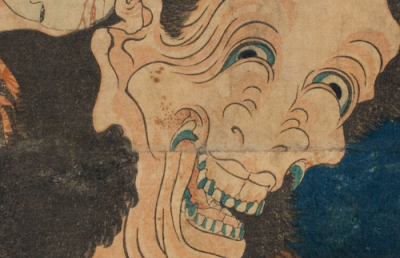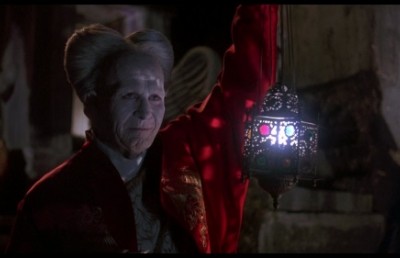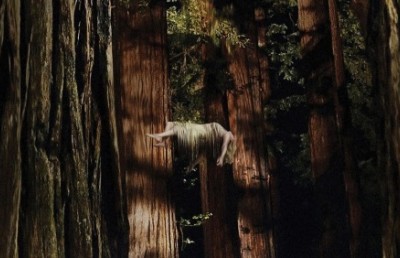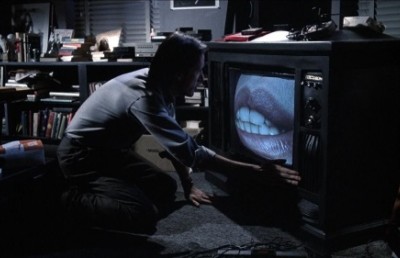Skinned: From Surgical Horror to Body Horror
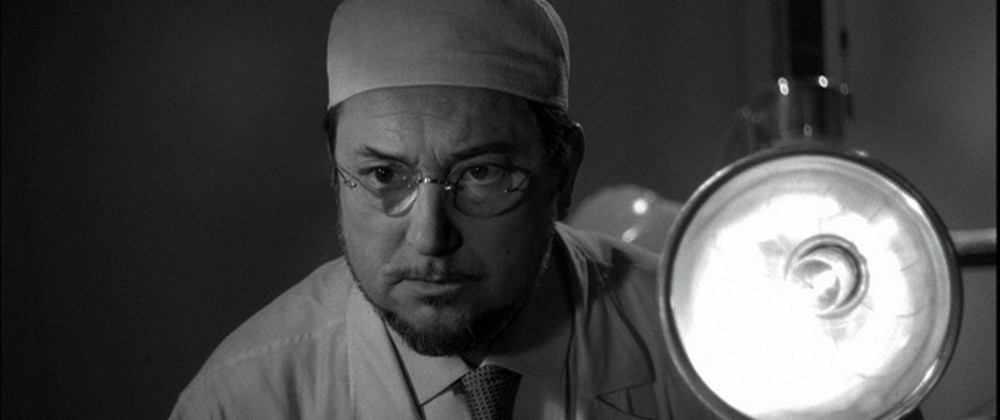
Warning: this essay contains graphic images of plastic surgery
Human history is filled with the search for beauty and perfection. From Ancient Egypt’s obsession with beauty in terms of makeup, skin care, hair/wigs and beauty remedies (Sooke, 2016), the toxic Elizabethan quest for pallor (Romm, 1987), several centuries of corseting, to surgical practices. Plastic surgery also has a long history, beginning in the 1400’s and growing during war time (“History of Plastic Surgery”), when soldiers would return from battle disfigured. These treatments were developed during a time of desperate need, but soon became a source of desire, or manufactured need. As the process became more advanced it also opened up a new market within the beauty industry. When something as violent as surgery becomes normalized, there will always be space for Horror to shake us back into our basic fears.
We currently live in a time when plastic surgery has become very common and accepted in society. In the West specifically, lip fillers and Botox are no longer for the rich and famous, they are accessible to the masses and have become normalized, even for adolescents, with the rise of the “Instagram model” and Kylie Jenner’s Lip Kits. Botox and fillers are no longer just to reverse the signs of aging, but to inhibit them from appearing to begin with. Breast implants and breast augmentation have also shifted from few to commonplace, no longer do we think of the anomaly of a celebrity like Pamela Anderson in the early 90’s, as part of the few having the elective surgery. And along with this more commonplace appearance, also came the rise in reality television series based around plastic surgery. These include shows like: Extreme Makeover (2002), The Swan (2004), Dr. 90210 (2004 – present), I Want a Famous Face (2004), as well as shows that normalize the trend and physically altered appearance like The Real Housewives of wherever (first series beginning in 2006 with Orange County), Keeping Up With the Kardashians (2007-present), etc. These shows demonstrate a surface solution for the deep anxieties present in living in today’s world. Patti White, as producer on Extreme Makeover explains: “[to] understand these shows, it’s worth looking at what made them so popular. ‘Makeover reality television took off after 9/11… People were trying to feel good because it was such a dark time for American culture. Extreme Makeover tapped into insecurities people had about themselves that hadn’t been broadcast before. The program said, “It’s okay to get plastic surgery. It’s okay to want to feel better about yourself”(Lord, 2018). When viewed as a symptom of cultural anxiety, we can see a direct link to the birth of the film subgenre Body Horror and more specifically Surgical Horror.
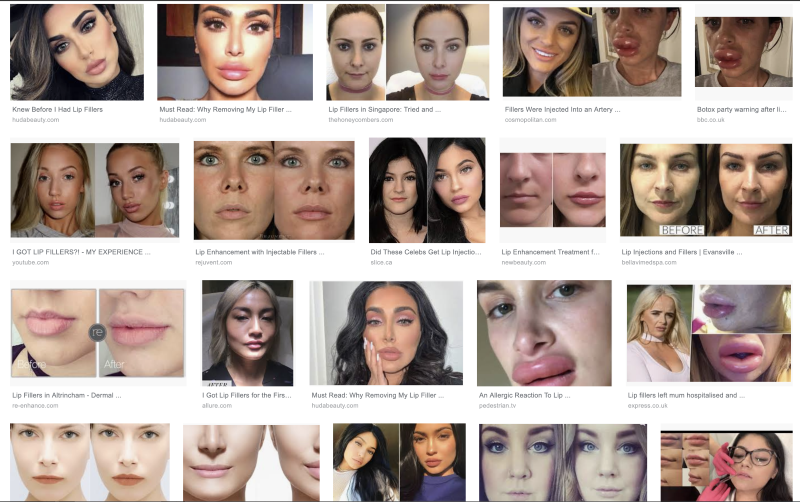

Body Horror as a subgenre was coined by Phillip Brophy in his article “Horrality: The Textuality of the Contemporary Horror Film”, written in 1983. He writes of the time in history when the fear switched from death to: “the fear of one’s own body, of how one controls and relates to it”(Brophy, 92). He claims that in this time period the tendency also turned from telling, to showing. His first example is from the 1976 film Deep Red, which appears between the Hitchcock era and the contemporary: “incorporating a mode that both ‘tells’ you the horror and ‘shows’ it” (92). He presents this film to show the change in direction from telling to showing, which was the true essence that propelled the subgenre forward. Body Horror as an official subgenre was birthed out of a fear and anxiety related to our bodies. This influx of body horror during the 80’s, can be seen as a direct correlation to the HIV/AIDS crisis in the early 1980’s, with special mention to director David Cronenberg, whose films are often read through the AIDS lens (Mathijs, 31). This moment in history and film, was when cultural fears turned from the outward other (metaphors and monsters), inward to the body, and biology being the cause of panic. Of course there was a long history of what we could now refer to as Body Horror occurring before this influx, most notably in writing, including of course it’s beginnings in Mary Shelley’s Frankenstein (1818), or tales of Werewolves (the use of body as transformative into monster), but the showing of these physical alterations in film could be linked back to the extremely influential film Les yeux sans visage (1960).
In 1960 the world was introduced to several influential serial killers in the films: Peeping Tom directed by Michael Powell, Psycho by Alfred Hitchcock, and Les yeux sans visage (Eyes Without a Face) by Georges Franju. In Les yeux we are introduced to the idea of a surgeon, a trusted medical professional, turned murderer. His focus is not in saving his daughter’s life, as she had survived a car wreck that killed her mother, but instead he sacrifices several young girls in order to save his daughter’s beauty. To Christiane however, her beauty is her life, as her father has locked her away from the public, falsifying her death while proceeding to practice facial transplants to restore her daughter’s beauty. It becomes clear that this surgery becomes an obsession for him, as he performs it and tests it multiple times hoping for his own personal success.
Throughout the film Christiane is presented to the viewer with a mask, allowing only her eyes to show. This not only protects us from seeing her face, but also provides us with a permanent unease and uncanniness, as she appears doll-like and ghostly, wandering the mansion in her very stylized wardrobe and porcelain face. It is not until 42 minutes into the film that we are allowed to see what lies beneath, revealing a scarred and disfigured face, blurred by the lens, while she backs up into the shadows to keep us from the extreme horror. It is in this moment that we have the first glimpse into her body’s horror, which is much like the scene in The Phantom of the Opera (1925) in which The Phantom’s disfigured face is revealed through an unfocused lens to the audience, and a horrified Christine. These scenes allow the viewer to take in a small dose of the shock, giving us reprise from the disfigured faces. It is but mere moments later in Les yeux sans visage, that we are given a true horrifying scene: the Surgical Horror.
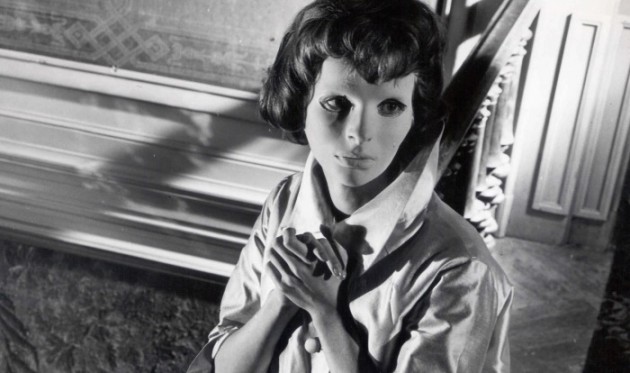
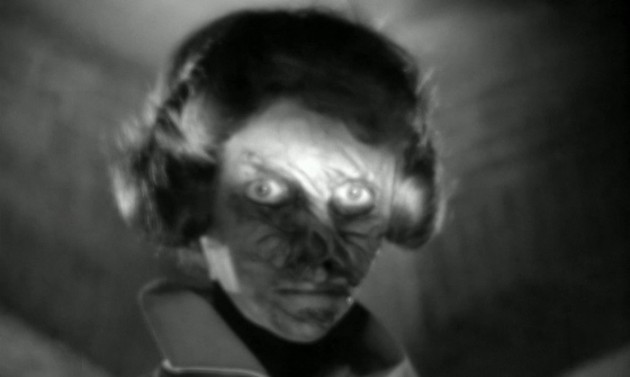
Les yeux sans visage
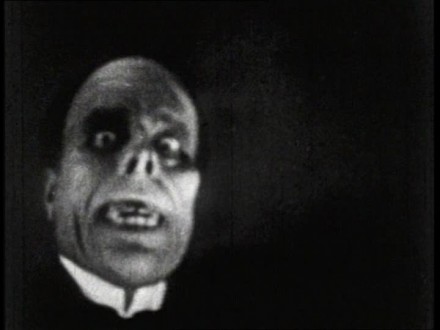
Phantom of the Opera (1925)
In the surgery scene the camera captures the details of the removal of a young victim’s face (Edna), displaying her in full view. Franju shows the scalpel cutting into her skin, and releasing the flesh from her. We are given access to the sight of her skinless face, like the removal of a flesh mask. This mask meant to replace the last, and the one before that; the endless cycle of surgeries to replace a face that no longer exists. This scene is quite similarly replicated in Jesus Franco’s 1987 unofficial remake, Faceless, which deals with botched operations and the disfigured face of a loved one. The film nears its end with this surgery scene, removing the face in one piece, and leaving behind a mutilated woman, whose unraveled eyes roll showing her silenced trauma.
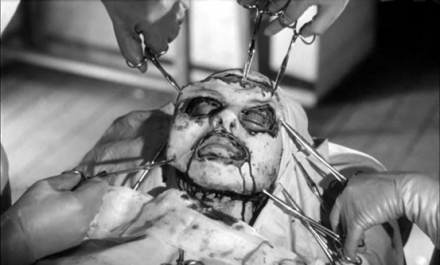
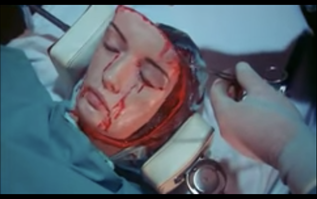
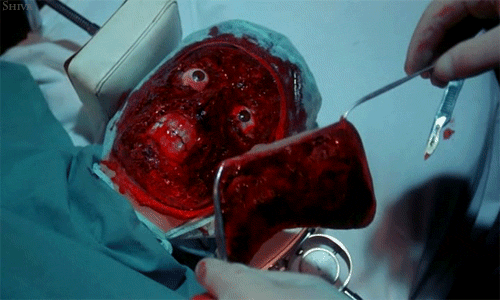
In a more contemporary example, Pedro Almodóvar’s 2011 film La piel que habito (The Skin I Live In) we see this theme amped up. The doctor in this film, Dr. Robert Ledgard becomes obsessed with creating a synthetic, flame resistant skin after his wife Gal survived a car accident where she was severely burnt. After her initial survival she stays locked up in their house, without mirrors, much like Christiane in Les yeux, only to finally see her reflection in a windowpane, jumping to her death out of the sheer horror of her face. Many years later, and after his daughter also commits suicide by jumping out a window, Robert kidnaps the man he thinks raped his daughter, Vincente, subjecting him to all his surgical studies, which includes a sex change where he transforms Vincente into Vera, his replacement for Gal, and the canvas for his new perfect skin.
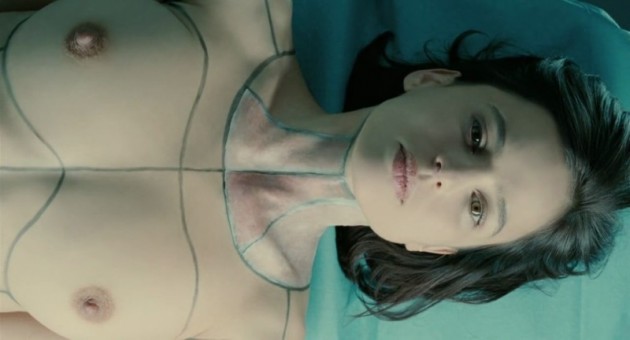
La piel que habito (2011)
In Xavier Aldana Reyes’ “Skin Deep? Surgical Horror and the Impossibility of Becoming Woman in Almodóvar’s The Skin I Live In”, he explains the changes in body horror to surgical horror in our contemporary setting. He writes: “we [can] trace a change in focus from body horror and its preoccupation with the mutation and alteration of flesh to more contemporary ‘bodily’ concerns: here the body becomes the object under attack by tyrannical individuals or, in some cases, companies or systems of punishment. One of the methods by which the genre has attained its current ‘bodily’ status is the turn to surgery as a source of anxiety. In fact, surgical horror could be seen as a logical conclusion to the postmodern subject’s fear of advances in science” (Aldana Reyes, 821). From this we can extrapolate that surgical horror is the new body horror of our modern time, as the shift from fears of disease turn to advancements in science i.e. surgery. Society is left feeling like it cannot keep up with the science. In Reyes’ book Body Gothic: Corporeal Transgression in Contemporary Literature and Horror Film, he points to Pete Boss’ writing from 1986 already showing this turn: “contemporary horror’s exploitation of ‘surgery, terminal illness, organ transplants and biomedical research … for their potentially disturbing values’. Boss saw this surgical investment as an effect of ‘the influence of medical technology and institutional bureaucracy’ on the subject and their body, and described it as ‘indicative not of a widespread interest in human physiology but of a closing-off or reduction of identity to its corporal horizons’” (145).
When we think of our fears of science they are often based around identity. Cloning, or AI human facsimiles, scare us because we like to believe we are individuals apart from all else. But this is something we are already confronting in smaller doses when we look back to plastic surgery. We are confronted in our everyday through social media, and the media in general, with plastic faces that all resemble one another. That strip the individuality from the individual.
The artists Xue Jiye, who currently lives and works in Beijing, also deals with skin and anxiety in his work. His body of work is mostly focused in painting and sculpture, and is centered around muscular, nude, pale, nondescript male figures. These men are ‘everyman’, they fit no one race and seem otherworldly in many ways, described on the website Escape Into Life as: “not as an individual person in a certain time, but as a human being in general” (“Artist Bio”). They are hairless, they are often white fleshed and featureless. They emit no emotion, yet provoke many emotions and anxieties in the viewer. The works are often referred to as magic realism, (a term coined by the German photographer, art critic and art historian, Franz Roh in 1925) (Tate), which is to say art that depicts “modern realist paintings with fantasy or dream-like subjects” (Tate). In some of the paintings, the ones I will be focusing on, we have the figure either peeling, shedding, or ripping the skin off his body in a process to uncloak or detach from his sealed epidermal confinements. These untitled paintings conjure up many disturbing emotions, presenting the viewer with a visual representation of what it feels like to be in between thought and physical action.
In Jiye’s artist bio on the website Escape Into Life, he explains that he has become bored with reality and that surrealism allows him the freedom to create. It’s further explained that, “life in society has made us all more and more numb. ‘Things that were once special have now become ordinary, boring and mundane’. His paintings take basic human actions and put them in imaginary contexts that mirror our real society – like science fiction” (“Artist Bio”). In this way we can see that his series of conformed men, mimic our societies conformation in work, appearance, and identity. The bio further explains that: “[through] this the artist shows a neutral view of society, which could almost be labelled as his own disenchantment with existence. Xue’s works show us that human society leads us to conformity, since when people exist together, everyone ends up attaching importance to a uniform set of ideas and values. No matter how much one struggles within Xue’s work or in reality, there is no escaping basic human conditions and society” (“Artist Bio”). As Jiye works with the mundane, we can see this link back to our world of conformity, i.e. plastic surgery. We conform out of anxieties, but it is the job of horror to confront us with the realities of what we have accepted as ‘normal’. With the influx of normalization of surgical manipulations, cutting into the skin, Jiye changes this normalization to create horrific images that shake us back into place.
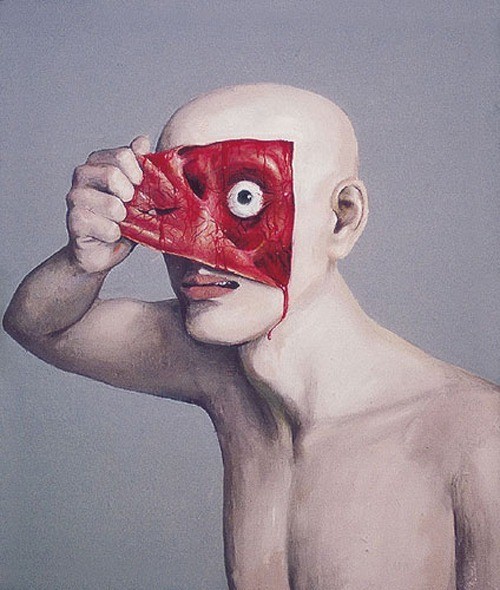
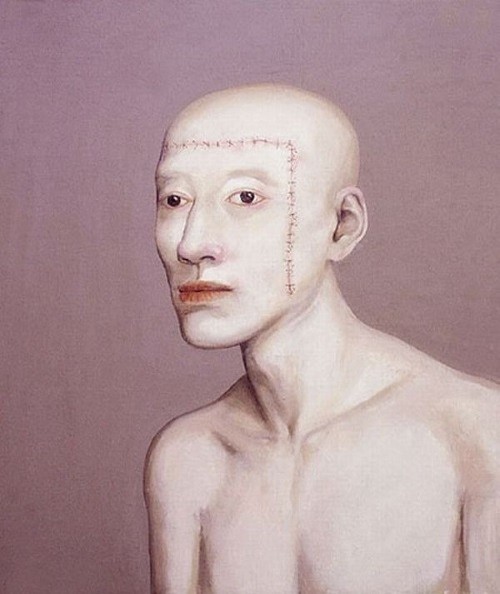
Untitled 2001, 51cmX61cm Diptych oil on canvas
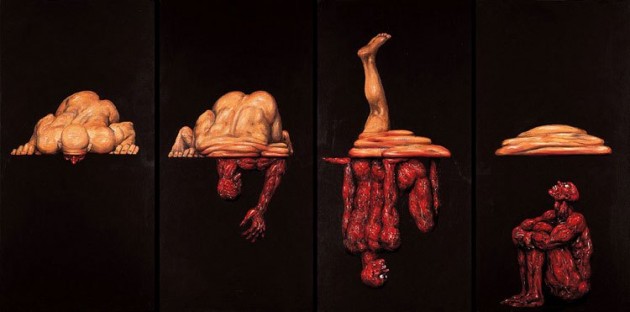
Untitled (To be or not to be) 2004, 120cmX60cm (each) quadriptych oil on canvas
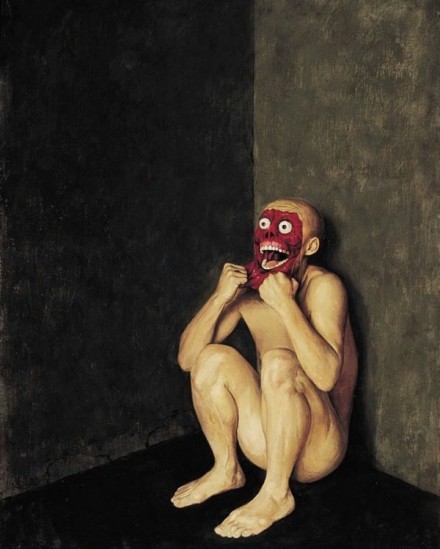
Untitled 2000, 145cmX110cm oil on canvas
Horror gleans from the socio political world in which it is produced, scenes within horror are not so unlike the scenes from the everyday. This is how they become so effective, they confront the viewer with the realities of the world, and in some cases even make them more palatable than their realities. Here we can see motifs of reality plastic surgery, mirrored in surgical horror which can be seen in scenes from Les yeux sans visage, John Frankenheimer’s Seconds (1966), Faceless (1987), and La piel que habito:
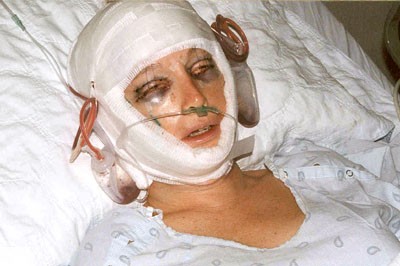
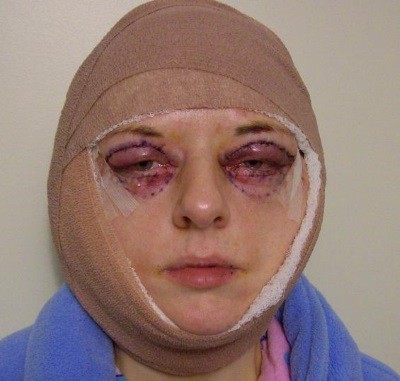
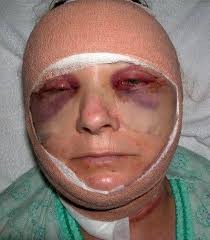
Recovery from Facelift surgeries
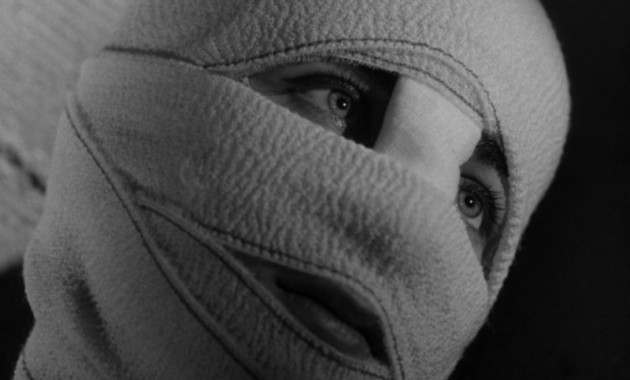

Les yeux sans visage (1960) La piel que habito (2011)
And here we have glamorized versions of facial bandages post-surgery, in both Les yeux sans visage and La piel que habito, with both characters as victim to unwanted surgery:
These visuals act as a way to deal with the horror and mutilation of the victims, in a way that keeps the imagery more glamorous, or aestheticized, than that of lived realities. While these victims do not choose to have these procedures done, media does not want to over horrify us with the realities of the everyday.
As shown, we have entered into a time in history when science and medicine have come so far that, (specifically in the West) our fears have been dissuaded from disease and shifted to beauty and the seeking of perfection, i.e. alteration from ourselves. Horror has seen this shift and has moved with the current, bringing these anxieties to the screen to reflect these fears back onto our complacent society. Surgical horror is the mirror of our societies circumstances, and we are far from leaving it behind. With the advancements in science we not only have more to fear, but we have more creative outlets in which to reflect those fears back unto ourselves.
BibliographyAustin, Guy. “Biological Dystopias: The Body in Contemporary French Horror Cinema.” L’Esprit Créateur 52, no. 2 (2012): 99-113.
Brophy, Philip. “Horrality: The Textuality of the Contemporary Horror Film”, Art and Text, 11(1983): 85–95.
Collins, Michael J. “The Body of the Work of the Body: Physio-Textuality in Contemporary Horror”, Journal of the Fantastic in the Arts, Vol. 5, No. 3 (19), Special Issue: Graduate Student Award Winning Papers (1993), pp. 28-35.
Escape Into Life. “Xue Jiye: Artist Bio.” Escape Into Life. Accessed April 2019. https://www.escapeintolife.com/artist-watch/xue-jiye/.
Laine, Tarja. (2006) “CINEMA AS SECOND SKIN”, New Review of Film and Television Studies, 4:2 (2006): 93-106.
Lord, Annie. “What It Was Like Being a Contestant on a 2000s-Era Cosmetic Surgery Makeover Show.” Broadly. December 19, 2018. Accessed April 2019. https://broadly.vice.com/en_us/article/7xyqgg/reality-tv-plastic-surgery-extreme-makeover-show.
Mathijs, Ernest. “AIDS References in the Critical Reception of David Cronenberg: ‘It May Not Be Such a Bad Disease after All’.” Cinema Journal 42, no. 4 (2003): 29-45.
Reyes, Xavier Aldana. Body Gothic: Corporeal Transgression in Contemporary Literature and Horror Film. University of Wales Press, 2014.
Reyes, Xavier Aldana. “Skin Deep? Surgical Horror and the Impossibility of Becoming Woman in Almodóvar’s ‘The Skin I Live In’.” Bulletin of Hispanic Studies, vol 90, issue 7, (2013): 819-834.
Romm, Sharom. “BEAUTY THROUGH HISTORY.” The Washington Post. January 27, 1987. Accessed April 2019. https://www.washingtonpost.com/archive/lifestyle/wellness/1987/01/27/beauty-through-history/301f7256-0f6b-403e-abec-f36c0a3ec313/?noredirect=on&utm_term=.8b2f4ab0e674.
Royal Free Hospital. “History of Plastic Surgery.” NHS Choices. Accessed April 2019. https://www.royalfree.nhs.uk/services/services-a-z/plastic-surgery/facial-reconstruction-and-face-transplants/history-of-plastic-surgery/.
Sooke, Alastair. “Culture – How Ancient Egypt Shaped Our Idea of Beauty.” BBC. February 04, 2016. Accessed April 2019. http://www.bbc.com/culture/story/20160204-how-ancient-egypt-shaped-our-idea-of-beauty.
Tate. “Magic Realism – Art Term.” Tate. Accessed April 2019. https://www.tate.org.uk/art/art-terms/m/magic-realism.
Toran, Noam. “The Unsettling Gaze.” Interwoven: The Fabric of Things. Accessed April 2019. http://kvadratinterwoven.com/the-unsettling-gaze.
Filmography
Almodóvar, Pedro, dir. La piel que habito. 2011; Spain, Blue Haze Entertainment, Canal+ España, El Deseo. 35mm.
Franco, Jesus, dir. Faceless. 1987; Spain, France, ATC 3000, Ibero Films Internacional S.A., Les Films de la Rochelle. 35mm.
Franju, Georges, dir. Les yeux sans visage. 1960; France, Italy, Champs-Élysées Productions, Lux Film. 35mm.
Frankenheimer, John, dir. Seconds. 1966; USA, Joel Productions, John Frankenheimer Productions Inc., Gibraltar Productions. 35mm.
Julian, Rupert and Lon Chaney, dir. The Phantom of the Opera. 1925; USA, Universal Pictures. 35mm.


